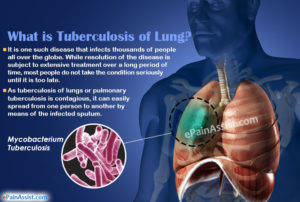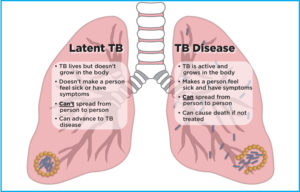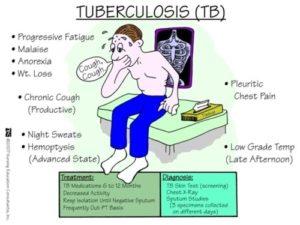Symptoms of active TB include a cough that contains thick, cloudy, and sometimes bloody mucus from the lungs, called sputum, for more than two weeks, tiredness and weight loss, night sweats and a fever, a rapid heartbeat, swelling of the lymph nodes, and shortness of breath and chest pain.
DIAGNOSIS:
There are numerous ways for a doctor to diagnose a patient with tuberculosis. Doctors can typically find latent, or not active, TB by doing a tuberculin skin test, where TB antigens are injected under the skin. If the patient has TB bacteria within their body, a red bump will appear at the injection spot in two days. A blood test can also be performed to detect if a patient has TB. For doctors to discover pulmonary TB, they will often test a sample of mucus from the lungs to see if the TB bacteria are present there. Other tests may include further testing on sputum, or mucus from the lungs, other blood tests, or a chest X-ray to find pulmonary TB. To diagnose extrapulmonary TB, a doctor may take a sample of tissue, or a biopsy, to test as well as a CT scan or an MRI to get a clear visual of the inside of the patient’s body.
TREATMENT:
In the majority of cases, doctors will combine four antibiotics to treat active TB, and it is essential for patients to take this medicine for a minimum of six months.
A majority of patients are cured of the TB bacteria if they take all the required medicine necessary to destroy the infection. If tests performed by a doctor reveal active TB is still present in the body after six months, treatment will continue for another two or three months. In the worst case scenario, if the TB bacteria is still resistant to multiple antibiotics, called multidrug-resistant TB, treatment will be necessary for one year or longer. Patients with latent TB may be treated with one antibiotic they consume daily for nine months or with a combination of antibiotics taken once a week for twelve weeks. Ensuring every dose is taken reduces the risk of a patient with latent TB to develop active TB.
There is no guaranteed way for an individual to prevent TB from happening to them or a loved one, but there are some helpful tips individuals can implement if they are at risk or around someone with active TB. As previously stated, latent TB is not contagious and extrapulmonary TB is much more challenging to spread compared to active pulmonary TB. One thing everybody can do to stop the spread of this infection is to get vaccinated, whether as a child or as an adult.
Individuals who are at risk of developing TB or who work with patients who have active TB should always wash and sanitize their hands after they have come into contact with the patient. If an individual is visiting a loved one with TB or taking care of a patient, due to the airborne nature of this infection, uninfected individuals should also keep a healthy distance and wear a mask to prevent them from coming into contact with TB bacteria. Patients who have severe TB should also be quarantined for a time to reduce the risk of spreading the disease as well.
Despite the stigma surrounding this curable disease, with the proper treatment and a bit of patience, individuals infected with tuberculosis can get onto the road to recovery and be healthy sooner rather than later!


